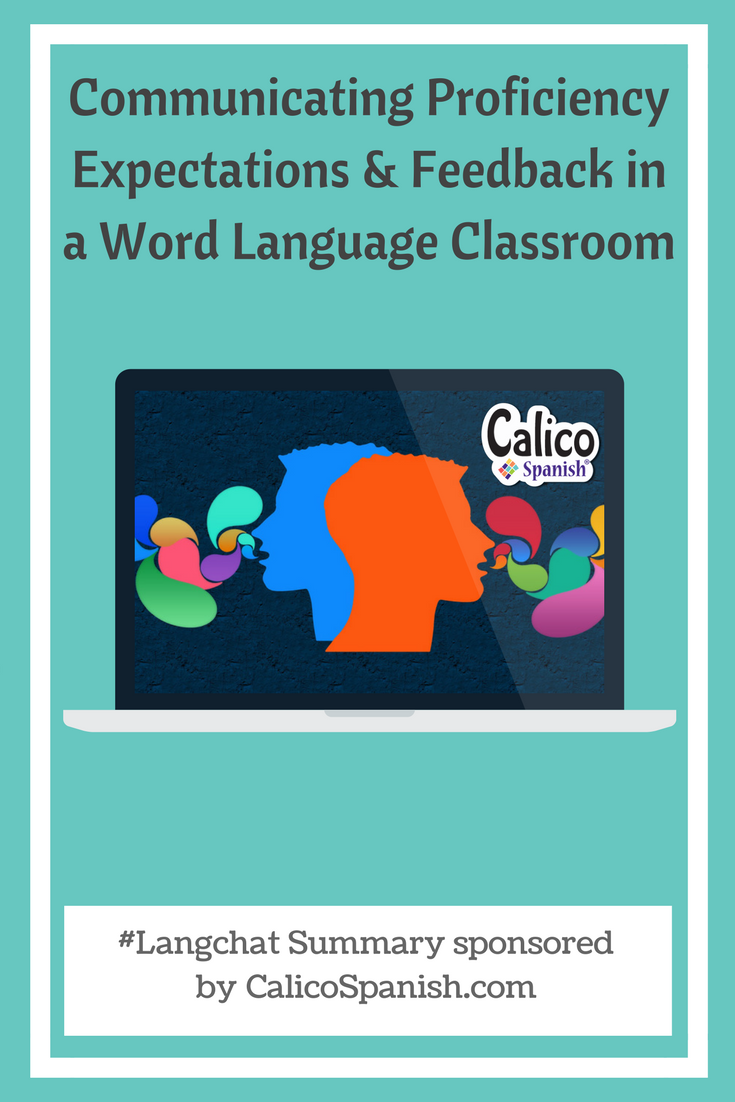Communicating Proficiency Expectations & Feedback in a Word Language Classroom

Last Thursday, #Langchat teachers discussed the challenge and importance of communicating proficiency expectations with students. Clear and understandable feedback on work was considered a necessary tool to this communication process and to student proficiency progress.
– Follow the blog on Bloglovin –
Communicating WHY Proficiency Levels are Key
#Langchat teachers want to see their students succeed in their target language. This is one of the many reasons behind why communication of proficiency levels between teachers and students is important in the world language classroom. Last week, #langchat participants explained why they share proficiency level goals with their classes.
- @welangley said, “I tell them where they should be to limit frustration when they can’t express everything they have in their head in L2.”
- @kkeefe_hassan said, “I think explaining proficiency helps foster realistic goals.”
- @senoraCMT believes:explaining [proficiency] is so [important, because students] need to know that being slower than others doesn’t mean they can’t
- @krisfauch strategizes this idea through “explaining proficiency levels as a roadmap- [Students] should have goals of where they want to be!”
- @MlleSulewski said:
[Students] can feel better about where they are and where they’re going! “Fluency” is a misnomer; anyone can be proficient!
– Like Calico Spanish on Facebook –
Feedback to Drive Proficiency
Students will often need feedback in order to be pushed to the next proficiency level. Individual and collective feedback can be given in a variety of ways. @senoritawood “meets one on one often…We go through strengths, weaknesses, and how to push further.” @SraWienhold said, “I always try to tell students what they can do to move to the next level as part of assessment feedback.” Positive affirmation and goal-setting proved to be common techniques in driving students to reach new proficiency targets. @MmeFarab said: “I do level spot-checks but also tell them something I loved and something they could do next time”. Some #Langchat teachers share feedback with students creatively. For example, @Sra_Kennedy uses “Bubble sheets color coded by [level]. [Students] can see progress over time & they want those blue Novice High bubbles!” Feedback is able to communicate the teacher’s expectations for the student.
– Follow Calico Spanish on Twitter –
Helpful Proficiency Rubrics for Students
#Langchat Teachers described what kinds of rubrics can be useful for students to assess their proficiency levels.
- @welangley said, “I like holistic for lower levels. For higher levels, I like to divide for constructs”
- @SraWienhold said, “I like when rubrics show above level, so students have chance to really exceed in certain areas, and see where to go”
- @jfh1790 said, “I utilize a simple Excel chart with a scaled number of points for each category. Helps [students] to see where they went wrong.”
- @MlleSulewski said, “I think a rubric that shows everything: where they’ve been and where they’re going.”
– Follow us on Instagram too! –
Online Tools for Instant Feedback
#Langchat Teachers shared their favorite online instant feedback tools.
- Edpuzzle is considered a great feedback tool for interpretive tasks (@sramartino).
- Schoology can personalize digital feedback (@GrowingFrench).
- “[I] love GoFormative, Classkick, Socrative, and more for online instant feedback” (@MmeFarab).
- “Google Classroom and goformative are great” (@senoritawood).
- “Kaizena and Orange Slice Google Doc add-ons” (@MmeCarbonneau)
- “I love Quizlet Live because they do recap at the end of ‘what we know’ and ‘what we need to work on’” (@MlleSulewski).
How to Allow Students to Self-Assess to Track Proficiency
When it comes to the mechanics of when and how to allow students to self-assess in order to track their proficiency, @klasekastellano said it best when she shared,“ ‘need to work on this’ seems to be the consensus. [#Langchat Teachers] have a similar struggle here.” However, teachers shared their best techniques:
- @cadamsf1 said, “I use Survey Monkey and Google forms when we are doing recordings or using iPads.”
- @mmeshep said, “I have students circle where they think their performance was on the rubric before I check the boxes.”
- @krisfauch said:
[Students] self-assess using Post-its in the proficiency level bulletin board in my room- great visual for the kiddos- and quick!
- @ICanSpanish said, “I like to videotape interpersonal [conversations] throughout the year, then they can self-assess at year end.”
Thank You
Thank you to all who participated in last week’s langchat. A special thank you to the lead moderator, Elizabeth (@SraDentlinger) for promoting the discussion on proficiency expectations and feedback in a world language classroom. Thank you to our support monitors, Laura (@sraspanglish), Megan (@MlleSulewski), and Colleen (@CoLeeSensei). Have a topic you’d like to discuss? Don’t forget to check out the #langchat wiki and suggest a topic!






No Comments